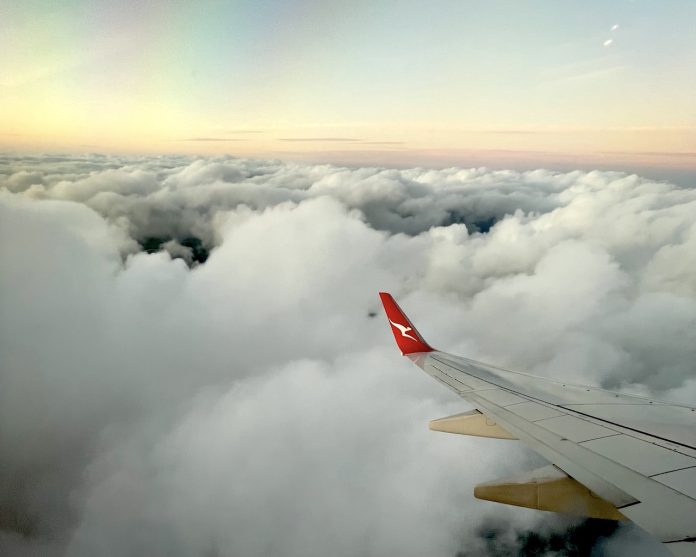Madeleine McKeown was heading for Perth airport when she was told her flight home was cancelled.
Every flight for seven days was booked, and no refund was available for more than a week.
The year twelve student missed a week of school, and paid twice the cost of her original flight.

Madeleine, dressed in school uniform, with her dad in 2022
“This was in year twelve. I missed a week of class and didn’t take my laptop… not only did I miss class but I couldn’t catch up.”
- Madeleine McKeown
Madeline’s story isnt uncommon. In the air travel industry, consumers are at the mercy of business.
In April 2025, only 82.4% of flights were on time, and one-in-fifty flights cancelled
What causes unreliable flights? And how can you avoid inconvenience?

Dr Cheng-Lung Wu, Associate Professor of Aviation at UNSW, explains why delays and cancellations unsettle travellers.
“They don’t tell you why it’s delayed. So sometimes that makes uncertainty for consumers.”
Dr Cheng-Lung Wu is a Specialist in aviation and data (photo: Airline Operations and Delay Management by Cheng-Lung Wu)
Some Context: Who are our players?

Australian aviation is an oligopoly: a market wherein a small cluster of firms controls everything.
Enter game theory, an economic field that analyses how oligopolies create ‘cartels’ that maximise profits.
Tail of Virgin Aircraft at Sydney Airport (photo: Siena Fagan)
Air transport has three protagonists: Virgin, Jetstar, and Qantas.
In the ‘All Routes’ category, the three divide fairly evenly, with Virgin and Qantas each at 35% of the market share. This pattern is similar for the larger cities to larger cities routes and larger cities to regions routes.
Qantas monopolises regional routes, with 83% of the market.
Few minor airlines remain. Rex controls 1.4% of all routes, and peaks at 7.3% of regional-to-regional routes.
“[In regional markets], it’s either monopoly or duopoly.
- Dr Cheng-Lung Wu
Bonza had held 41.9% of the regional market before entering voluntary administration in April 2024.
Its death allowed greater domination by the bigger airlines.
Barriers to entry make it notoriously difficult to break oligopolies.
Dr Wu describes this issue within the aviation market.
“You can only make money, you can only profit, where you can scale it up, when you can create a larger network, more frequent flights, and then you will be able to profit from there.”

Sunshine Coast Airport, in Marcoola, is a minor airport with only four gates (photo: Siena Fagan)
But what is the benefit of more airlines?
Competition drives incentives.
More companies competing will charge lower prices, and offer better deals, or extra perks.
Who cancels the most?
Dr Wu outlines why flights are cancelled.
“Typically cancellations happen because of mechanical issues, engineering issues, because, you know, technically the aircraft cannot go.”
“Cancellations also happen for commercial reasons….it was a known industry tactic to reduce spending.”
For example, an airline with enough passengers to fill two flights spread across three scheduled planes, would cancel one and reassign passengers, receiving the profits of running three flights, with only the cost of two.
While effective in profit-making, this tactic is now less common, as airlines face scrutiny for manipulating the market. Many assume that there is a simple equation to save yourself from delays and cancellations: more money spent = less time wasted.
But how valid is this?
The average percentage of cancellations in 2023 was 2.762%. Bonza sports the highest rate, at 13.431%, while Qantas produces the least, at 1.454%
The ‘luxury’ airlines were split by this average – with Qantas and Virgin coming in under, and QantasLink and Virgin Regional (the prior’s regional subsidiaries) over.
Rex only cancelled 1.970% of scheduled flights.
It’s not clear that paying more guarantees reliability. Qantas, the most ‘luxury’ airline, may have the least cancellations, but there is no pattern.
Airlines aren’t the only businesses that control the industry. Airports monopolise cities, and influence air travel efficiency.
Each airport has a unique set of routes – from Hobart, with three destinations, to Sydney’s nineteen.
Sydney and Melbourne both had the highest number of cancellations of 10,201 and 8,137 respectively. Sydney was the most frequently cancelled destination from all other Capitals
The exception was Darwin with only two routes, and no cancellations in 2023.
It is clear the busiest airports and routes have the highest cancellation numbers.
Does that mean that the airports are cancelling flights?
Not necessarily… but they certainly facilitate it.
According to the Australian Travel Industry Association (ATIA), airports policies govern how many flights an airline can cancel before they lose a given time slot.
For example, if Jetstar has a flight from Adelaide to Sydney every Wednesday at 11am, then they are only allowed to cancel a certain percentage of weeks in the year.
Most airports follow the “80/20 rule” – stipulating an airline can cancel 20% of scheduled flights in a given time slot without penalty.
ATIA argues that airports should shift to a 95/5 rule.
“The advantage of changing the 80/20 rule to a 95/5 rule is that this reduces the number of times in the year that an airline can cancel a slot from 10 to between 2 and 3.”
- Dr Tony Webber in “Slot Misuse and its Impact” by the Australian Travel Industry Association
To gauge the impact of such a policy shift, we can look at the number of people who would be affected by different percentages of allowed cancellations.
The 80/20 rule is reflected on the far right of the graph, and the 95/5 rule on the far left.
A clear cluster of airports has lowest cancellations rates: Perth, Adelaide, Hobart, Canberra, and Darwin. Sydney and Melbourne are close to one another with the most affected passengers, with Brisbane in the middle.

Sydney Airport Domestic Terminal (photo: Colleen Morgan)
While it’s not true that all airlines will cancel flights 20% of the time (otherwise they would lose customer loyalty), the 80/20 rule makes significant cancellation rates possible.
What can I do to avoid my flight getting cancelled?
Not much. There isn’t a strong enough correlation between budget airlines and cancellations.
Dr Wu believes the best way to reduce cancellations is to make airlines release more data regarding flight changes.
“In Australia, BITRE doesn’t publish detailed on time performance data, and airlines only provide the aggregate information.”
“So from there, consumers don’t know why a particular flight was delayed or cancelled, but in Europe or in the US, you can go to the air consumers report. They asked airlines to submit flight by flight data in terms of on time performance and baggage handling. So you know why a particular flight was delayed or cancelled, for what reason.”
With a greater range of unaggregated data, airlines could be held more to account for cancellations. For example, a 9am Melbourne to Sydney flight may have 0% cancellations, compared to a 11:30am Adelaide to Cairns flight may be cancelled 20% of the time.
Behind the Data – Real People and Real Stories
Madeleine McKeown Still looks back on her unplanned stay in Perth with anger. She was left all alone, with no help from the businesses that promise to ‘bring you home’.
But her story isn’t unique.
Asha was flying from Rockhampton to Sydney, via Brisbane. Both flights were delayed separately, and she arrived at her destination 7 hours late.
Alana was stranded in Ballina airport after her flight was delayed by 10 hours (that is, two hours longer than It would’ve taken to drive to Sydney).
Madeleine is not alone in her experience – nor is Asha, or Alana.
This much is clear: since there’s nothing that consumers can do to help themselves, it’s high time that corporations do something to help their loyal customers.
Siena Fagan is an Economics and Media Student at the University of Sydney. She works part-time at the ABC, and is passionate about finding the hidden economic relationships in the world around us!



